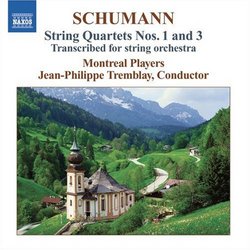| All Artists: Robert Schumann, Jean-Philippe Tremblay, Montreal Chamber Players Title: Schumann: String Quartets Nos. 1 & 3 (Transcribed for String Orchestra) Members Wishing: 0 Total Copies: 0 Label: Naxos Original Release Date: 1/1/2006 Re-Release Date: 9/26/2006 Genre: Classical Styles: Chamber Music, Historical Periods, Classical (c.1770-1830) Number of Discs: 1 SwapaCD Credits: 1 UPC: 747313013371 |
Search - Robert Schumann, Jean-Philippe Tremblay, Montreal Chamber Players :: Schumann: String Quartets Nos. 1 & 3 (Transcribed for String Orchestra)
 | Robert Schumann, Jean-Philippe Tremblay, Montreal Chamber Players Schumann: String Quartets Nos. 1 & 3 (Transcribed for String Orchestra) Genre: Classical
|
Larger Image |
CD Details |
CD ReviewsExcellent!! classicalmusiclover | manchester, ct | 10/23/2006 (5 out of 5 stars) "I strongly support the insighful review by Scott Morrison and only wish to add that the sound is also quite good. Another outstanding Naxos release!" They COULD Have Been Written for String Orchestra! J Scott Morrison | Middlebury VT, USA | 10/04/2006 (5 out of 5 stars) "As far as I know there has been no previous recording of a string ensemble version of any of Schumann's three quartets. Here we have two of them -- Nos. 1 & 3 -- in arrangements by a Montreal violist/conductor, Jean-Philippe Tremblay, conducted by him and played by some of his Quebec colleagues, most of them from the Orchestre Symphonique de Montréal. And what a job they do! Schumann's quartets are the quintessential Romantic quartets with frequent changes of mood -- in Schumann's case often from feverish agitation to fragility and introspection and back -- and when played by a string quartet they are tricky, to say the least, for the players to coordinate; the players have to all be on the save wave-length. Translate that to a string ensemble and you have a recipe for disaster. Quite clearly this group are capable of following Tremblay's lead and they play as one player. Marvelous!
The arrangements, as is usually the case with quartets made into string ensemble pieces, do not alter the instrumentation of the quartet all that much. Tremblay adds double basses at strategic moments, but generally the violin, viola and cello sections play very much as they would if playing individually in a quartet. There are allowances made for the thickening of texture and indeed the timings are slightly longer than one generally gets in performances of the quartets. But this does not translate into a sludgy texture at all. Indeed, for instance, in the scherzo of No. 3 we have almost Mendelssohnian lightness. Some movements, as translated to a string orchestra texture, are more successful than others: both scherzi are terrific as are the first and fourth movements of No. 1, the finale of No. 3. The two slow movements are, for me, a bit less convincing than in their quartet guise, although they seem to be played nicely enough. The most interesting thing is that I suspect anyone coming to these arrangements without prior knowledge of the quartets themselves would be convinced that they had been written for string orchestra. One hears anticipations of, say, Elgar's writing for string ensemble and even Tchaikovsky's string writing. The Montreal Players are reported in the accompanying booklet to be preparing recordings of Tremblay arrangements of quartets by Tchaikovsky and the two sextets by Brahms. Bring them on! Scott Morrison" |

 Track Listings (8) - Disc #1
Track Listings (8) - Disc #1